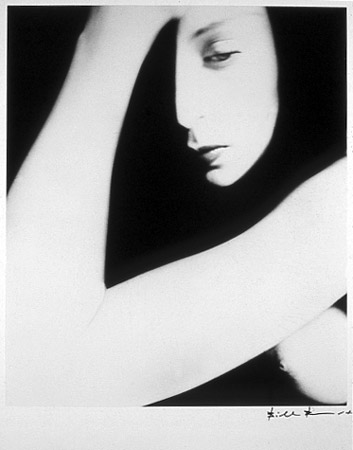 Art & Photography Art & Photography
In his city scenes, landscapes and nude studies, German-born Bill Brandt captured the spirit of Britain like no other photographer. Yet, says Sebastian Smee, he was unconcerned with reflecting 'truth'
The wonderful Bill Brandt retrospective at the Victoria & Albert Museum opens with a short video showing Brandt, towards the end of his life, talking about his work. In a few dreamy, oddly accented sentences, the photographer many regard as Britain's greatest describes London during the Blitz: "The blackout was absolutely fantastically beautiful. So soft, so soft. It was like stage lighting." This centenary exhibition, in the V&A's new photography space, reproduces some of this atmosphere in a darkened room punctuated only by Brandt's subtly spotlit prints hung in single file along the walls. It is a lovely space to walk into, the only distraction being Brandt's voice ("as loud as a moth," as one friend put it) emitted continuously from the monitor in the corner.
His recollections are reminders, if any were needed, that Brandt had the kind of poetic impulses we no longer seem to want from photographers. He was a man who talked about "atmosphere", who read poetry and looked to modern art for inspiration.
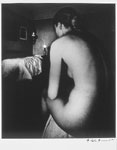 He didn't care too much about photography's factual tendencies. In fact, some of his best work was done in the darkroom, adjusting tones. One picture here shows Brandt's brother Ralph posing as a stranger in a London alley, which was shot in daylight but subsequently changed into a night scene. He didn't care too much about photography's factual tendencies. In fact, some of his best work was done in the darkroom, adjusting tones. One picture here shows Brandt's brother Ralph posing as a stranger in a London alley, which was shot in daylight but subsequently changed into a night scene.
In his creative disregard for literal "truth", Brandt was blatantly following the lead of his friend and mentor, Brassai, whose photographs of thugs and prostitutes were usually staged in an attempt to recreate the Paris of yesteryear, the glittering jewel of a city with its sordid underside; eros cavorting with thuggery.
But the German-born Brandt was in love with Britain, and his landscapes are some of the most evocative pictures of Britain ever taken. Cumulatively, they feel like abstract variations on a theme of greys and velvety blacks, with some blistering whites thrown in for punctuation.
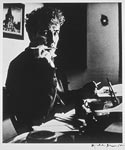 In Gull's Nest, Midsummer's Night, Isle of Skye, we find Brandt meditating on the astonishing variety of textures contained in one relatively straightforward scene. The picture shows three speckled eggs placed against a pure white feather and a nest consisting of long bright dashes of straw. All this is huddled into a sheltered corner of dark rock covered in grey lichen. In Gull's Nest, Midsummer's Night, Isle of Skye, we find Brandt meditating on the astonishing variety of textures contained in one relatively straightforward scene. The picture shows three speckled eggs placed against a pure white feather and a nest consisting of long bright dashes of straw. All this is huddled into a sheltered corner of dark rock covered in grey lichen.
Above it is a contrasting band of inky, saturated black, another band of water coolly reflecting a low sun, a range of black mountains in the distance, and, finally, a lighter grey sky pockmarked by dark grey clouds. The variation is entrancing, but it exists within a wider, poetic unity, and this contrast between particularity and wholeness is what makes the picture so great.
The fact that the landscapes come under the heading here of "Literary Britain" alerts us to the fact that, although Brandt spent his career trying to make photographs look real, his work actually embodied a pre-existing vision, 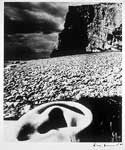 nurtured in the mind and deeply informed by literature. Has Brandt's already dangerously nostalgic vision been turned into cliché in the hands of others? Absolutely. nurtured in the mind and deeply informed by literature. Has Brandt's already dangerously nostalgic vision been turned into cliché in the hands of others? Absolutely.
To look at a marvellous picture such as Brandt's Unemployed miner returning home from Jarrow (1936) or his high-spirited and strikingly balanced East End girl dancing the Lambeth Walk (1939) is to feel that one has seen it before - on a poster in someone's bedroom, perhaps, or in a coffee-table book romanticising life before TV.
Unfortunately, the same goes for his nudes, which one sees imitated endlessly in magazines and books devoted to the artful nude. But all this is scarcely Brandt's fault; it is rather the inevitable by-product of choosing a mechanical medium in which to be creative.
Brandt's nudes are, in fact, his greatest, most original achievement. Wanting to include the ceilings in his interior pictures, he got hold of a camera with a very wide-angle lens. The resulting pictures contained some drastic distortions, which he saw he could use.
Indeed, like Degas, who used the arbitrary framing of the photographic snapshot as the basis for a new kind of painting, he elevated the camera's "mistakes" into a great style.
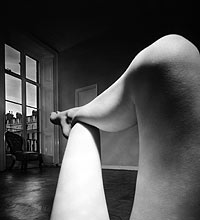 Nude, Belgravia, London (1951) shows a pair of erotically elongated white legs stretching from the vantage point of the viewer toward a window on the left. The distortion produces a sensation of unbelievable elegance. But this contrasts with the hard floorboards, the chair and the buildings across the street. Nude, Belgravia, London (1951) shows a pair of erotically elongated white legs stretching from the vantage point of the viewer toward a window on the left. The distortion produces a sensation of unbelievable elegance. But this contrasts with the hard floorboards, the chair and the buildings across the street.
Such little incursions of grubby reality at first seem extraneous to the solution of the artistic problem. But, in fact, as Brandt knew - and as too many of his imitators with their preference for slick studio nudes forget - they are the things that give the picture life, contrast and a considerable touch of menace.
|
